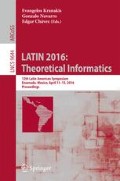Abstract
Edge crossings in a graph drawing are an important factor in the drawing’s quality. However, it is not just the presence of crossings that determines the drawing’s quality: any drawing of a nonplanar graph in the plane necessarily contains crossings, but the geometric structure of those crossings can have a significant impact on the drawing’s readability. In particular, the structure of two disjoint groups of locally parallel edges (bundles) intersecting in a complete crossbar (a bundled crossing) is visually simpler—even if it involves many individual crossings—than an equal number of random crossings scattered in the plane.
In this paper, we investigate the complexity of partitioning the crossings of a given drawing of a graph into a minimum number of bundled crossings. We show that this problem is NP-hard, propose a constant-factor approximation scheme for the case of circular embeddings, where all vertices lie on the outer face, and show that the bundled crossings problem in general graphs is related to a minimum dissection problem.
Access this chapter
Tax calculation will be finalised at checkout
Purchases are for personal use only
References
Dahlhaus, E., Johnson, D.S., Papadimitriou, C.H., Seymour, P.D., Yannakakis, M.: The complexity of multiterminal cuts. SIAM J. Comput. 23(4), 864–894 (1994). http://dx.doi.org/10.1137/S0097539792225297
Eppstein, D., van Kreveld, M.J., Mumford, E., Speckmann, B.: Edges and switches, tunnels and bridges. Comput. Geom. 42(8), 790–802 (2009). http://dx.doi.org/10.1016/j.comgeo.2008.05.005
Fink, M., Pupyrev, S., Wolff, A.: Ordering metro lines by block crossings. J. Graph Algorithms Appl. 19(1), 111–153 (2015). http://dx.doi.org/10.7155/jgaa.00351
Füredi, Z., Palásti, I.: Arrangements of lines with a large number of triangles. Proc. Am. Math. Soc. 92(4), 561–566 (1984). http://dx.doi.org/10.1090/S0002-9939-1984-0760946-2
Garey, M.R., Johnson, D.S.: Crossing number is NP-complete. SIAM J. Algebraic Discrete Methods 4(3), 312–316 (1983). http://epubs.siam.org/doi/abs/10.1137/0604033
Holten, D.: Hierarchical edge bundles: visualization of adjacency relations in hierarchical data. IEEE Trans. Vis. Comput. Graph. 12(5), 741–748 (2006). http://doi.ieeecomputersociety.org/10.1109/TVCG.2006.147
Holten, D., van Wijk, J.J.: Force-directed edge bundling for graph visualization. Comput. Graph. Forum 28(3), 983–990 (2009). http://dx.doi.org/10.1111/j.1467-8659.2009.01450.x
Hu, Y., Shi, L.: A coloring algorithm for disambiguating graph and map drawings. In: Duncan, C., Symvonis, A. (eds.) GD 2014. LNCS, vol. 8871, pp. 89–100. Springer, Heidelberg (2014). http://dx.doi.org/10.1007/978-3-662-45803-7_8
Huang, W., Hong, S.H., Eades, P.: Effects of crossing angles. In: Proceedings of 7th International IEEE Asia-Pacific Symposium Information Visualisation (PacificVIS 2008), pp. 41–46 (2008). http://dx.doi.org/10.1109/PACIFICVIS.2008.4475457
Schaefer, M.: The graph crossing number and its variants: asurvey. Electron. J. Comb. Dyn. Surv. 21, 1–100 (2013). http://www.combinatorics.org/ojs/index.php/eljc/article/view/DS21
Soltan, V., Gorpinevich, A.: Minimum dissection of a rectilinear polygon with arbitrary holes into rectangles. Discrete Comp. Geom. 9(1), 57–79 (1993). http://dx.doi.org/10.1007/BF02189307
Acknowledgments
The research of Martin Fink was partially supported by a fellowship within the Postdoc-Program of the German Academic Exchange Service (DAAD), and by NSF grants CCF-1161495 and CCF-1525817. The research of Subhash Suri was partially supported by NSF grants CCF-1161495 and CCF-1525817.
Author information
Authors and Affiliations
Corresponding author
Editor information
Editors and Affiliations
Rights and permissions
Copyright information
© 2016 Springer-Verlag Berlin Heidelberg
About this paper
Cite this paper
Fink, M., Hershberger, J., Suri, S., Verbeek, K. (2016). Bundled Crossings in Embedded Graphs. In: Kranakis, E., Navarro, G., Chávez, E. (eds) LATIN 2016: Theoretical Informatics. LATIN 2016. Lecture Notes in Computer Science(), vol 9644. Springer, Berlin, Heidelberg. https://doi.org/10.1007/978-3-662-49529-2_34
Download citation
DOI: https://doi.org/10.1007/978-3-662-49529-2_34
Published:
Publisher Name: Springer, Berlin, Heidelberg
Print ISBN: 978-3-662-49528-5
Online ISBN: 978-3-662-49529-2
eBook Packages: Computer ScienceComputer Science (R0)

